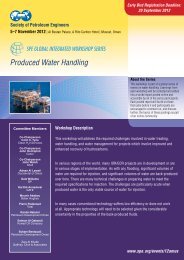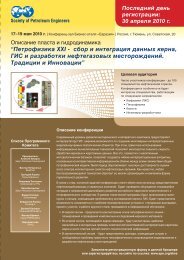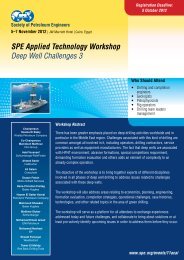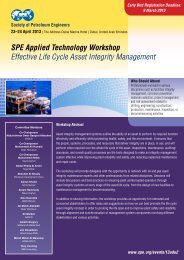SPE Distinguished Lecturer Program - Society of Petroleum Engineers
SPE Distinguished Lecturer Program - Society of Petroleum Engineers
SPE Distinguished Lecturer Program - Society of Petroleum Engineers
You also want an ePaper? Increase the reach of your titles
YUMPU automatically turns print PDFs into web optimized ePapers that Google loves.
<strong>SPE</strong> <strong>Distinguished</strong> <strong>Lecturer</strong> <strong>Program</strong><br />
The <strong>SPE</strong> <strong>Distinguished</strong> <strong>Lecturer</strong> <strong>Program</strong> is funded principally<br />
through a grant from the <strong>SPE</strong> Foundation.<br />
The society gratefully acknowledges the companies that support<br />
this program by allowing their pr<strong>of</strong>essionals to participate as<br />
lecturers.<br />
Special thanks to the American Institute <strong>of</strong><br />
Mining, Metallurgical, and <strong>Petroleum</strong><br />
<strong>Engineers</strong> (AIME) for its contribution to<br />
the program.<br />
<strong>Society</strong> <strong>of</strong> <strong>Petroleum</strong> <strong>Engineers</strong><br />
<strong>Distinguished</strong> <strong>Lecturer</strong> <strong>Program</strong><br />
www.spe.org/dl<br />
www.senergyltd.com
The Strategic Significance and<br />
Practicalities <strong>of</strong> CO2 EOR and Storage<br />
David S Hughes<br />
(david.hughes@senergyworld.com)<br />
Carbon Storage Specialist<br />
USA, April 2009<br />
<strong>Society</strong> <strong>of</strong> <strong>Petroleum</strong> <strong>Engineers</strong><br />
<strong>Distinguished</strong> <strong>Lecturer</strong> <strong>Program</strong><br />
www.spe.org/dl<br />
www.senergyltd.com
Geological Storage <strong>of</strong> CO2<br />
• New business stream for oil industry<br />
• Store liquid CO2 in depleted oil and gas fields<br />
and also saline aquifers<br />
• Synergies with existing operations through<br />
reuse <strong>of</strong> infrastructure etc. and possibility <strong>of</strong><br />
increasing hydrocarbon recovery<br />
• Contributes to the fight on global warming<br />
• Has value through Cap and Trade<br />
arrangements such as the EU emissions trading<br />
scheme<br />
• But comes with regulations and liabilities<br />
• Uses all our skills
IPCC Prediction <strong>of</strong> Requirement for<br />
Carbon Capture and Storage (CCS)<br />
• From ~2030 amount <strong>of</strong><br />
CO2 that requires to be<br />
stored is ~4 billion<br />
tonnes/year, rising to<br />
~18 billion tonnes/year<br />
in 2095<br />
• c.f.3.9 billion<br />
tonnes/year oil<br />
production and 2.5<br />
billion tonnes oil<br />
equivalent/year gas<br />
production in 2005<br />
2030<br />
From IPCC Special Report on Carbon Dioxide Capture and Storage 2005 and BP Statistical Review, 2006
CO2 Flooding is a Major Enhanced Oil<br />
Recovery (EOR) Process in USA<br />
CO2 to Canada<br />
Weyburn<br />
25,000 bbl/d<br />
En Cana<br />
2006 statistics<br />
• 45 million tonnes fresh<br />
CO2 injected per year<br />
(USA)<br />
• 53 projects USA (80<br />
worldwide)<br />
• ~180,000 b/d USA<br />
(~260,000 b/d<br />
worldwide)<br />
• 1/3 <strong>of</strong> one percent <strong>of</strong><br />
world production<br />
Rockies<br />
5 Fields – Additional 2<br />
Proposed (Anadarko)<br />
19,520 Gross Bbls/d<br />
Operators:<br />
Exxon/Chevron/Merit<br />
CO 2 Source:<br />
Natural/Manufacturing<br />
LeBarge<br />
McElmo<br />
Dome<br />
Ridgeway CO 2<br />
Discovery<br />
Permian Basin<br />
42 Fields<br />
155,000 Gross<br />
Bbls/d<br />
Operator: Multiple<br />
(16)<br />
CO 2 Source:<br />
Natural<br />
Sheep<br />
Mountain<br />
CO2 supply<br />
network<br />
Bravo<br />
Dome<br />
Great Plains<br />
Coal<br />
Gasification<br />
Plant<br />
Gas<br />
Plants<br />
Mid-Continent<br />
4 Fields<br />
9,800 Gross Bbls/d<br />
Operators:<br />
Exxon/Anadarko/Chaparral<br />
CO 2 Source: Manufacturing<br />
Ammonia<br />
Plant<br />
Jackson<br />
Dome<br />
Eastern Gulf Gulf Coast<br />
3 Fields<br />
8,000 Gross Bbls/d<br />
Operator: Denbury<br />
CO 2 Source: Natural
World Coal Resources
Contribution to UK CO2 Emissions<br />
From Power Sector<br />
• UK CO2 emissions 2008<br />
532 million tonnes*<br />
• About 1/3 from fossil<br />
fuelled power stations<br />
• 23 million tonnes at Drax<br />
in England<br />
• 10 million tonnes at<br />
Longannet in Scotland<br />
*UK DECC, 26 March 2009
UK Commitment to Reduction in CO2<br />
Emissions<br />
• Under Kyoto Protocol UK committed to reducing greenhouse<br />
gas emissions by 12.5% from their 1990 level by 2008-2012<br />
(achieved 23% to 2008*)<br />
• 2008 Climate Change Act has set legally binding targets for<br />
the UK to reduce greenhouse gas emissions by at least 80%<br />
by 2050, and CO2 emissions by at least 26% by 2020, from<br />
1990 base (achieved 13% CO2 reduction to 2008*)<br />
• Also requires the Government to set five year carbon budgets,<br />
in order to set out a trajectory for emissions reductions to<br />
2050<br />
• Government sees Carbon Capture and Storage<br />
(Sequestration) making a significant contribution towards<br />
achieving these targets<br />
• Principal funding mechanism issuing allowances and allowing<br />
them to be traded (EU Emissions Trading Scheme)<br />
*UK Department <strong>of</strong> Energy and Climate Change, 9 February and 26 March 2009
Fighting Climate Change (a year ago)<br />
We’re fighting<br />
climate<br />
change with<br />
techna-ology<br />
We’re<br />
legislating
Fighting Climate Change (now)<br />
We’re<br />
legislating<br />
We’ve<br />
legislated
Decarbonisation <strong>of</strong> UK Fossil Electricity<br />
Supply<br />
PetaJoule (10 15 Joule)<br />
1 MWh = 3.6 10 9 Joules<br />
UK Power Generation – Scenario<br />
with 80% cut in CO2 Emissions<br />
• Plan for UK fossil power supply<br />
to be decarbonised (coal) by<br />
2030<br />
• CO2 Capture rates (million<br />
tonnes per year)<br />
2020-<br />
25<br />
2025-<br />
30<br />
2030-<br />
35<br />
2035-<br />
40<br />
2040-<br />
45<br />
2045-<br />
50<br />
18 82 145 180 202 206<br />
From Heather Haydock, AEA, City and Financial CCS<br />
Summit, 2 and 3 December 2008
Proposed New Power Stations with CO2<br />
Capture and Storage<br />
CO2 (mill te/y)<br />
21<br />
15<br />
5<br />
CO2 Captured<br />
• Proposed programme would<br />
capture up to 80 million tonnes<br />
per year at 90% load factor<br />
• So in 50 years 2 - 4 billion<br />
tonnes needs to be stored<br />
depending load factor<br />
3 6<br />
3<br />
8<br />
6<br />
10<br />
CO2 Storage Options<br />
• Oil fields including enhanced<br />
oil recovery (EOR)<br />
• Depleted gas fields<br />
• Saline aquifers<br />
Map: ENDS Report July 2007
Coal<br />
Oil<br />
Natural Gas<br />
Capture Options (~90%)<br />
H 2 +CO 2 H 2 +CO<br />
• Coal 900 kg CO2 per MWh<br />
• Gas 400 kg CO2 per MWh<br />
Exhaust, 0.3 - 0.5% CO 2<br />
Power Plant<br />
Conventional<br />
CO 2<br />
Capture<br />
2H 2 + O 2 2H 2 O<br />
Gasification<br />
Reforming<br />
Water-<br />
Shift<br />
CO 2<br />
Capture<br />
Power Plant<br />
Hydrogen-rich fuel<br />
CO 2<br />
storage<br />
Post Combustion Capture<br />
Pre-combustion Capture<br />
Oxyfuel Combustion<br />
H 2 for other uses<br />
Exhaust,<br />
0.1 - 0.5% CO 2<br />
CH 4 + O 2<br />
Power Plant<br />
Oxy-fuel<br />
combustion<br />
CO 2 + 2H 2 O<br />
Air<br />
Separation<br />
Water<br />
Removal
Sources and Potential Sinks <strong>of</strong> CO2<br />
Around North Sea<br />
Geographical<br />
Information System<br />
– Decision Support<br />
System<br />
Part <strong>of</strong> EU<br />
GESTCO Project<br />
British Geological<br />
Survey, February 2005
SNS Gas Fields CO2 Storage Potential<br />
• 53 fields most Permian<br />
Leman Sandstone<br />
• Proven geological trap for<br />
hydrocarbon gas<br />
• Near to CO2 sources<br />
• Existing infrastructure<br />
• Well and pressure depletion<br />
may have compromised trap<br />
• Aquifer influx may reduce<br />
capacity<br />
• CO2 capacity ~2.8 billion<br />
tonnes
SNS Bunter Sandstone CO2 Storage<br />
Potential<br />
• A number <strong>of</strong> potentially<br />
suitable saline aquifers have<br />
been identified with<br />
cumulative capacity maybe<br />
10s billions tonnes<br />
• For example SNS Bunter<br />
sandstone<br />
– 29 closed structures<br />
– Good porosity (average 18.7%)<br />
and permeability<br />
– 650-9800 ft deep<br />
– Near to CO2 sources<br />
– Good seal (mudstones and<br />
evaporites) - gas bearing in<br />
places proves trap (or not!)<br />
– Some existing infrastructure<br />
– Cut by faults which may leak<br />
Material on SNS gas field and aquifer storage from: An assessment <strong>of</strong><br />
carbon sequestration potential in the UK – SNS case study, Michele<br />
Bentham, January 2006, Tyndall Centre
CO2 EOR Onshore - Advantages<br />
• CO2 supply network<br />
• High well density, pattern flood, relatively<br />
cheap to redrill/refurbish<br />
• Relatively low secondary recovery (35-45%)<br />
• Phased implementation<br />
• Large surface area available for facilities<br />
• Currently economic
CO2 EOR Offshore - Challenges<br />
• Limited CO2 supply (at least at present)<br />
• Fewer wells, peripheral flood, expensive new<br />
wells and workovers<br />
• High secondary recovery (55-70%)<br />
• Single implementation (i.e. no chance to<br />
introduce the project in phases)<br />
• Existing facilities mainly incompatible with<br />
high CO2 content in fluids<br />
• Limited weight and space for new facilities<br />
• Estimated UK North Sea EOR-related CO2<br />
capacity 0.5-1.9 billion tonnes (1-2.8 billion<br />
barrels incremental oil)<br />
• But probably need $100 barrel for <strong>of</strong>fshore EOR<br />
to be economic
Well Density – Onshore vs. Offshore<br />
10 acre spacing (660ft sq) 600 acre spacing (5500ft sq)<br />
http://www.opec.org/home/Press%20Room/EU-OPEC%20presentations/Iain%20Wright%20-%20Presentation.pdf
UK Carbon Capture, Transport and<br />
Storage Competition<br />
• Single CCS project up to 100% funding<br />
(around £1 billion)<br />
• Offshore disposal <strong>of</strong> CO2<br />
• Coal (including oxyfuel) with post-combustion<br />
capture (i.e. using technology that can be<br />
retro-fitted and capable <strong>of</strong> being deployed in<br />
China etc.)<br />
• 300 - 400 MW (~ 2 million tonnes/y <strong>of</strong> CO2)<br />
• First CO2 capture and storage by 2014<br />
• Discussions ongoing with three consortia to<br />
close contract in September 2009<br />
• One <strong>of</strong> 10 - 12 demonstration projects in EU<br />
by 2015
Sleipner CO2 Storage Project<br />
Images: Alligator film /BUG / Øyvind Hagen StatoilHydro<br />
• Natural gas in Sleipner<br />
contains 9 mol% CO2<br />
• Offshore chemical capture<br />
plant reduces CO2 content<br />
<strong>of</strong> gas for export to
Weyburn CO2 EOR, Saskatchewan,<br />
Canada<br />
200 mile pipeline - 2 million tonnes/year (~100 million scf/d)<br />
130 mill barrel<br />
30 mill te CO2
Weyburn - 4D Seismic Monitoring
CCS Activity Map<br />
Canada<br />
USA<br />
Norway<br />
UK<br />
Europe<br />
Algeria<br />
UAE<br />
India<br />
Japan<br />
China<br />
South Africa<br />
Australia
USA CO2 Emissions and Reduction Targets<br />
• GHG emissions in 2005 were 7206 million (metric)<br />
tonnes CO2 equivalent (actual CO2 emissions were<br />
6032 million tonnes or 84% <strong>of</strong> total)<br />
• Compared with 1990, 2007 CO2 emissions were<br />
20% higher (34% higher from electricity generation)<br />
• Kyoto target (non- signatory) was a reduction <strong>of</strong> 7%<br />
• Reduction targets in Henry Waxman (House<br />
Energy and Commerce Chairman) bill are 3% by<br />
2012, 20% by 2020, 42% by 2030 and 83% by<br />
2050 compared with 2005 base<br />
• Note that the 2050 figure is 66% reduction<br />
compared with 1990 base<br />
http://www.eia.doe.gov/oiaf/1605/ggrpt/carbon.html<br />
American Clean Energy and Security Act <strong>of</strong> 2009 (Draft), 30 March 2009
American Clean Energy and Security Act <strong>of</strong><br />
2009 (Draft)<br />
• Act will establish Carbon Storage Research<br />
Corporation with role to seed fund commercial<br />
scale CCS with levy on fossil fuelled electricity<br />
generation <strong>of</strong> $1 billion per annum for ten years<br />
• Also establishes coordinated approach to permitting<br />
and certifying geological storage sites including<br />
subsurface property rights<br />
• Establishes reporting and regulation regime for<br />
CO2 injection sites including those associated with<br />
enhanced hydrocarbon recovery<br />
• Deals with liabilities for closed sites<br />
American Clean Energy and Security Act <strong>of</strong> 2009 (Draft), 30 March 2009
Establishes US Wide Cap and Trade System<br />
• Allowance trading system from 2012 covering<br />
power utilities, oil companies and large<br />
industrial sources totaling 85% <strong>of</strong> GHG<br />
emissions (>25,000 tonnes/year)<br />
• Number <strong>of</strong> allowances reduced each year to<br />
meet emissions reduction targets<br />
• 100% auctioning <strong>of</strong> allowances (23% revenue<br />
used for clean energy investment rest returned<br />
to people, communities and businesses)<br />
• Trading system designed to establish and<br />
maintain an effective, transparent, and fair<br />
market for emissions allowances and preserve<br />
the integrity <strong>of</strong> the cap on emissions<br />
American Clean Energy and Security Act <strong>of</strong> 2009 (Draft), 30 March 2009
US Projected Power Generation by Fuel Type<br />
and CO2 Emissions (Unabated)<br />
US DOE/NETL Carbon Sequestration<br />
Atlas <strong>of</strong> USA and Canada, 2008<br />
American Clean Energy and<br />
Security Act <strong>of</strong> 2009 (Draft),<br />
30 March 2009
US CO2 Emissions from Power Sector<br />
• From power sector<br />
– 2.4 billion tonnes/y<br />
CO2 (US)<br />
– 5-6 billion tonnes/y<br />
CO2 (worldwide)<br />
• Growing substantially<br />
– Expected to be by<br />
1/3 rd in US over next<br />
20 years without<br />
action to reduce<br />
emissions<br />
CO2 emissions from electricity generation<br />
(blue circles) and other industrial sources
US CO2 Storage Options<br />
• Oil and gas fields 91<br />
billion tonnes (red)<br />
• Saline formations<br />
3378 billion tonnes<br />
(blue)<br />
• Unmineable coal<br />
seams 202 billion<br />
tonnes (yellow)
FutureGen<br />
(Original Project May Be Revived)<br />
• 245 MW IGCC (gasifies coal to<br />
produce hydrogen and CO2)<br />
• In December 2007 awarded to<br />
Mattoon Township, Coles<br />
County, Illinois<br />
• 1 million tonnes CO2 per<br />
annum to be stored in saline<br />
formation below site<br />
• Funding canceled in January<br />
2008 because <strong>of</strong> escalating<br />
costs ($1.8 billion gross, 74%<br />
from DOE)<br />
• In March 2009 Secretary <strong>of</strong><br />
Energy Steven Chu<br />
expressed support for<br />
reviving FutureGen using<br />
stimulus funds<br />
• Part <strong>of</strong> a larger portfolio <strong>of</strong><br />
international demonstration<br />
projects<br />
• Cost now estimated at $2.3<br />
billion
FutureGen<br />
• Original single project program restructured mid-2008<br />
to provide grants to multiple projects ($100-600 million<br />
each)<br />
• Total available around $1.3 billion<br />
• 300-600 MW IGCC with Carbon Capture<br />
• Goal <strong>of</strong> 90% capture (minimum 81%)<br />
• CCS demonstration for 3-5 years with monitoring<br />
continuing for further 2 years<br />
• At least 1 million tonnes per year <strong>of</strong> CO2 at each<br />
project<br />
• Applications closed 8 th October 2008<br />
• Start 2015
Regional Carbon Sequestration Partnerships<br />
• Joint government and industry initiative to determine the most suitable<br />
technologies, regulations, and infrastructure needed for CCS<br />
• Geographical differences in fossil fuel use and sequestration sinks<br />
across the US dictate regional approaches<br />
• Seven partnerships:<br />
– Big Sky Regional Carbon Sequestration Partnership (Big Sky)<br />
– Plains CO2 Reduction Partnership (PCOR)<br />
– Midwest Geological Sequestration Consortium (MGSC)<br />
– Midwest Regional Carbon Sequestration Partnership (MRCSP)<br />
– Southeast Regional Carbon Sequestration Partnership (SECARB)<br />
– Southwest Regional Partnership on Carbon Sequestration (SWP)<br />
– West Coast Regional Carbon Sequestration Partnership<br />
(WESTCARB)<br />
• Network includes 350+ state agencies, universities, and private<br />
companies, spanning 41 states, two Indian nations, and four Canadian<br />
provinces<br />
http://www.netl.doe.gov/technologies/carbon_seq/partnerships/partnerships.html
Hydrogen Energy’s IGCC with CCS in<br />
California<br />
• Application for Certification<br />
before the California Energy<br />
Commission filed 31 July<br />
2008<br />
• Located in Kern County<br />
(moved from Long Beach)<br />
• Fuelled by petroleum coke or<br />
coke/coal blends<br />
• 390 MW gross output<br />
• 2+ million tonnes/y CO2<br />
captured (90%)<br />
• Used for enhanced oil<br />
recovery and storage in<br />
Occidental’s nearby Elk Hills<br />
oil field
Business Model<br />
• Three distinct types <strong>of</strong> activity<br />
– Power generation<br />
– Transportation (pipelines and ships)<br />
– Storage and EOR<br />
• Each has their own stakeholders,<br />
regulation regime, tax regime, subsidy<br />
entitlement<br />
• How are interests aligned?<br />
• Business model(s) will evolve over next<br />
decade
Conclusions<br />
• CO2 storage is a substantial new business for<br />
the oil industry<br />
• Uses most <strong>of</strong> our skills but is a significant<br />
challenge<br />
• Is an absolute necessity to make significant<br />
reductions in CO2 emissions<br />
• Opens up the use <strong>of</strong> vast coal stocks<br />
• Provides energy security through diversity<br />
• Enables hydrogen to be used as energy carrier
Acknowledgements<br />
• <strong>SPE</strong> <strong>Distinguished</strong> <strong>Lecturer</strong> <strong>Program</strong><br />
• Senergy for allowing me to participate<br />
One day training course<br />
Introduction to the Geological Storage <strong>of</strong> Carbon Dioxide (CO2)<br />
Course outline at: www.senergyworld.com/training

















